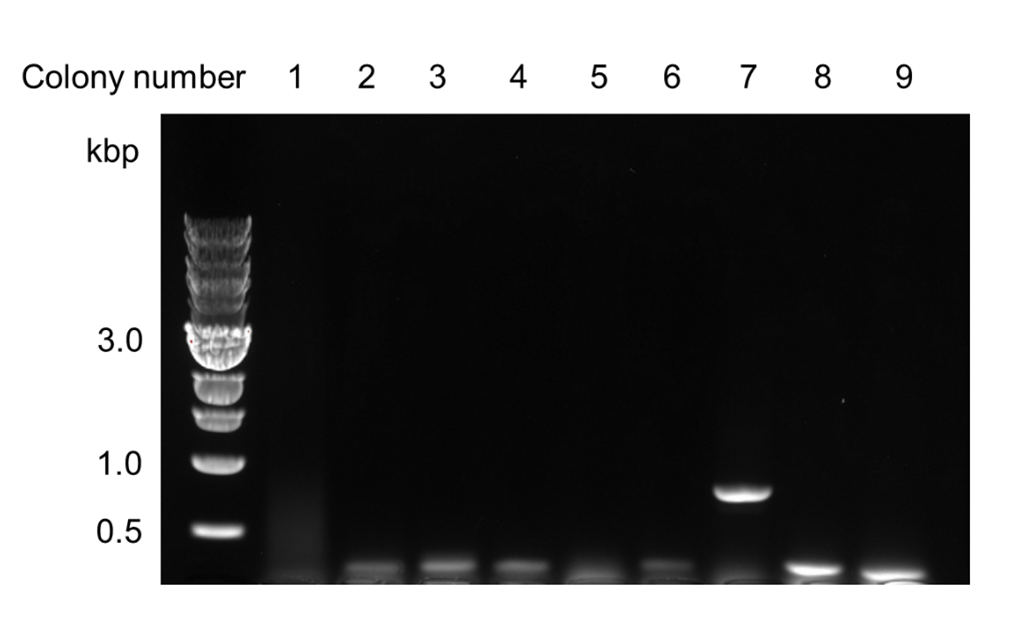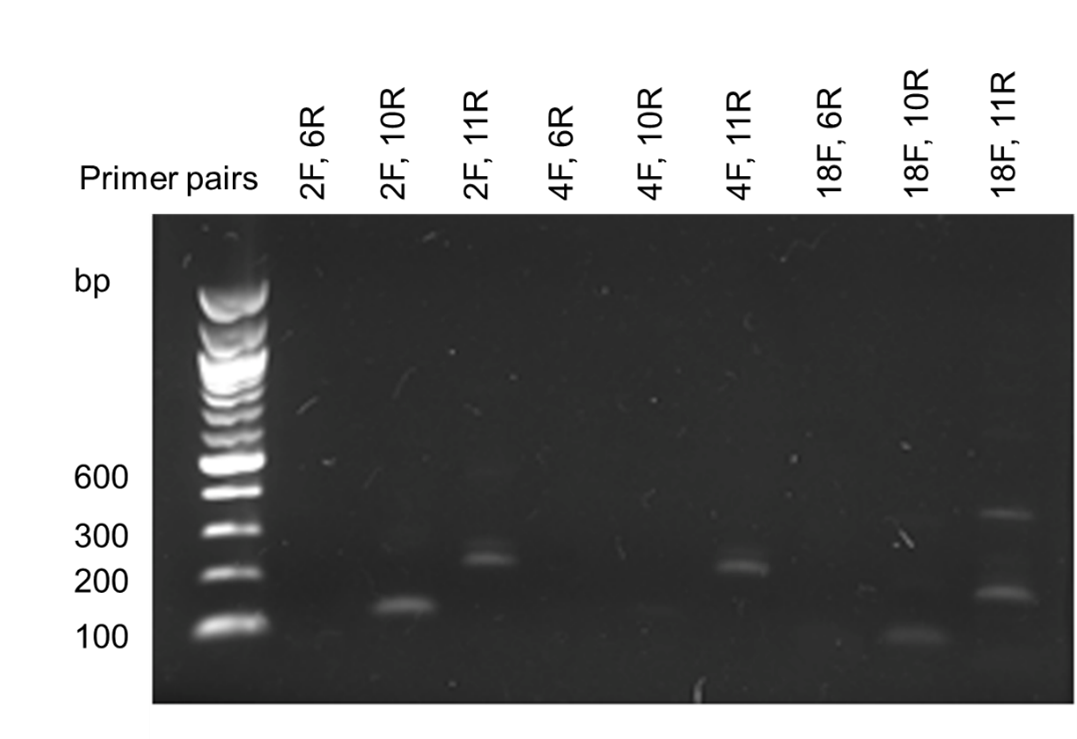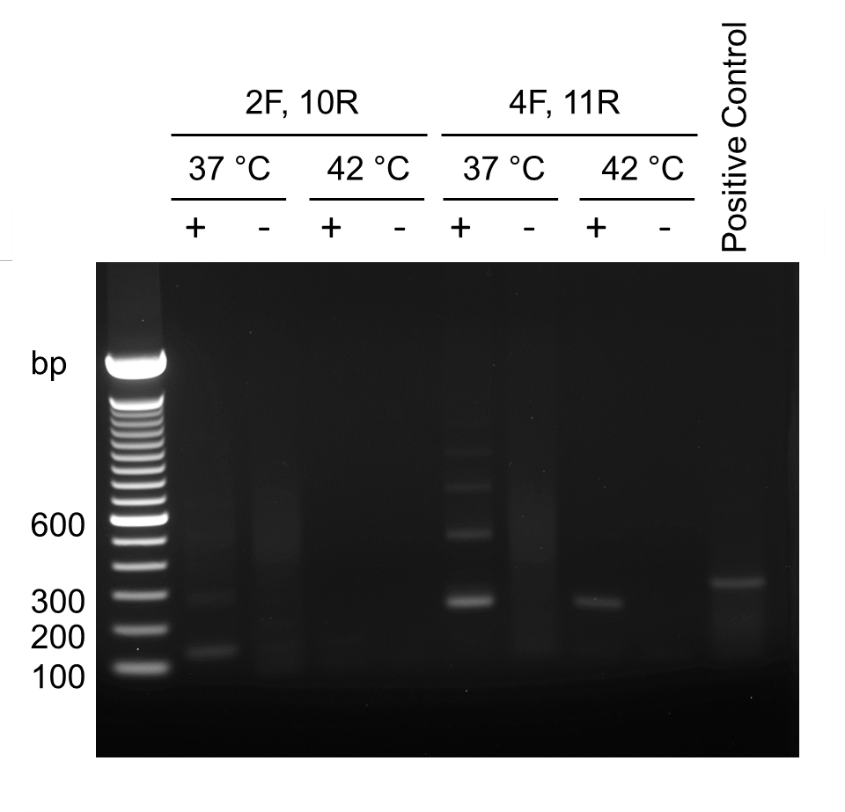Amplification of the CSN2 gene
For the detector system to work, we need to develop field-compatible systems for extracting DNA from cows, which will serve as the template for amplification of the CSN2 gene. We also require positive control DNAs that will serve to validate the amplification, and downstream detection of the A1 and A2 CSN2 alleles. The CSN2 gene must then be copied to ensure that a signal sufficient to be detectable is present. We elected to use RPA for this, as RPA can be performed at a constant temperature.
Sourcing CSN2 DNA
We began by building positive control DNAs that could be immediately used to develop and optimize protocols for amplification of the CSN2 gene, and detection of the A1/A2 alleles. To do this we found the CSN2 gene for Bos taurus using NCBI. This gene is located on chromosome 6, is 8,691 base pairs long, and contains nine exons (Figure 1) (1). Exon 7 is the longest at 498 base pairs and houses the SNP difference between the A1/A2 alleles at base pair 74 (2,3). The SNP creates an amino acid substitution in the β-casein protein (Figure 2) (3,4).

Figure 1. Structure of the CSN2 gene. Introns are represented as a gray line, exons as a blue box. Exon lengths and the location of the A1/A2 allele SNP are also depicted.

Figure 2. The A1/A2 SNP creates an amino acid substitution in the β-casein protein. In the amino acid chain, the SNP at Exon 7 base pair 74 changes the A1 allele from a histidine to a proline in the A2 allele.
To distinguish between the two alleles, we decided that we only needed to amplify exon 7. Smaller DNA is easier to manipulate and requires less synthesis, so we decided on amplifying a portion of Exon 7 that includes our SNP at nucleotide 74 because we will only need it as a positive control.
The A2 version of the gene was ordered for synthesis using the CSN2 sequence found through NCBI (GenBank: EF628290.1). With the SNP located, we also created and ordered an A1 version of the gene, by substituting an A-T base pair for the C-G present at base pair 74. We cloned the A1 and A2 alleles into pSB1C3. After, we transformed E. coli DH5α with the constructs, and performed colony PCR to confirm the presence of the insert. Colony PCR demonstrated that the A2 allele insert was effectively cloned into pSB1C3 (Figure 3), however we were unable to confirm the presence of the A1 allele (data not shown).

Figure 3. Colony PCR to confirm cloning of the A2 allele of CSN2 exon 7. The A2 allele of exon 7 was synthesized and then cloned into pSB1C3. E. coli DH5α were transformed with the constructs and colony PCR was performed to confirm presence of the insert
We then researched what we would have to do to obtain and use actual bovine DNA samples in our system. We looked in the literature and found that most bovine genetic tests are performed using hair follicles as a source of DNA (5-7). Our school requires that any research plan that uses animals must be approved by the Institutional Animal Care and Use Committee (IACUC). We wrote an IACUC application planning to obtain hair and saliva samples from dairy cows located at a local organic dairy farm, with the permission of, and under the supervision of the owner of the cows. Once obtained, we will use these samples to test field DNA extraction methods and to validate our detector system. This application was crosschecked with the iGEM Safety Committee and was approved.
Amplifying the target sequence with RPA
To detect the SNP located in exon 7, an amplification process is needed to generate enough DNA of the target DNA to test. We decided to use RPA as our means to amplify the exon 7 sequence, since RPA does not require thermocycling. This makes RPA a simpler method for amplifying DNA in a field setting (8). Like PCR, RPA also needs a set of DNA specific primers to amplify the region of interest. We researched commercial sources of RPA materials and discovered one supplier, TwistDx (9).
Primer Design and Optimization of RPA Reaction Conditions
RPA guidelines recommended the following: RPA primers to be a length of 30-35 nucleotides, GC content between 30 and 70 percent, and a low potential for homo/heterodimers (8). We designed primers to these specifications covering varying regions of Exon 7 that include the SNP using Primer Blast by NCBI (10). In total we created 18 pairs of primers of the requisite length and GC content. We then used IDTs OligoAnalyzer tool to check for hairpins, self and heterodimerization. We selected three forward primers: 2F, 4F, 18F; and three reverse primers: 6R, 10R, 11R, for testing (Figure 4).

Figure 4: Primers selected for use in RPA Amplification.
We began optimizing primer selection, by pairing all the forward primers with all possible reverse primers; the purpose of this was to see which primer pairs worked the most effectively together. We then performed RPA using the TwistDx kit, using a 40-minute amplification, performed at 37 °C. We observed RPA product bands at the predicted size for several primer combinations (Figure 5). Based on the expected amplicon lengths and strength of bands, we decided to choose primer pairs 2F:10R, and 4F:11R as candidates for further optimization of the RPA protocol.

Figure 5. RPA primer pair optimization. Combinations of forward and reverse RPA primers were used to perform RPA on A2 exon 7 positive control DNA. RPA products were subjected to agarose gel electrophoresis.
In the next round of optimization, we worked to determine reaction conditions that are ideal for these primer pairings. Each set was tested under the same reaction conditions except for reaction temperature. We performed reactions for each primer set at 37°C and at 42°C (Figure 6).

Figure 6. RPA temperature optimization. RPA reactions using the indicated primer pairs were run at 37°C or 42 °C for 40 minutes. RPA products were subjected to agarose gel electrophoresis.
Based off the results of this gel, we determined that pair 2F, 10R works best at 37°C and pair 4F, 11R works well at both temperatures. In the case of primer pair 4F, 11R, we observed additional bands of a higher than predicted molecular weight in the 37°C reaction.
Unfortunately, due to the SARS-CoV2 outbreak, we experienced a 6-week delay in receiving our RPA kit. As a result, we were unable to complete optimization for these two primer sets before we lost lab access. Since we observed several non-specific bands that form a ladder-like pattern in some of the reactions. We hypothesize that these are intermediates that form due to duplexing of products. We intend on continuing optimization of the reaction by testing reaction time, as well as product yield before deciding a final reaction scheme.
References
- CSN2 casein beta [Bos taurus (cattle)] - Gene - NCBI. Ncbi.nlm.nih.gov. (2020). Retrieved 23 October 2020, from https://www.ncbi.nlm.nih.gov/gene/281099
- Pal, S., Woodford, K., Kukuljan, S., & Ho, S. (2015). Milk Intolerance, Beta-Casein and Lactose. Nutrients, 7(9), 7285–7297. https://doi.org/10.3390/nu7095339
- Mercier, J. C., & Vilotte, J. L. (1993). Structure and function of milk protein genes. Journal of dairy science, 76(10), 3079–3098. https://doi.org/10.3168/jds.S0022-0302(93)77647-X
- Kamiński, S., Cieślińska, A., & Kostyra, E. (2007). Polymorphism of bovine beta-casein and its potential effect on human health. Journal of Applied Genetics,48(3), 189-198. doi:10.1007/bf03195213
- A1/A2 Determination - Eurofins USA - Eurofins USA. (n.d.). Retrieved October 20, 2020, from https://www.eurofinsus.com/food-testing/services/testing-services/dairy/a1a2-casein-determination/
- Beta-casein (A2 Genotyping). (n.d.). Retrieved October 20, 2020, from https://vgl.ucdavis.edu/test/a2-genotyping
- Dairy Trait and Condition Testing. (n.d.). Retrieved October 20, 2020, from https://genomics.neogen.com/en/dairy-trait-and-condition-testing
- Lobato, I., & O'Sullivan, C. (2018). Recombinase polymerase amplification: Basics, applications and recent advances. Trac Trends In Analytical Chemistry, 98, 19-35. https://doi.org/10.1016/j.trac.2017.10.015
- Recombinase Polymerase Amplification, or RPA, is the breakthrough, isothermal replacement to PCR. (n.d.). Retrieved October 24, 2020, from https://www.twistdx.co.uk/en/rpa
- Primer designing tool. (n.d.). Retrieved October 24, 2020, from https://www.ncbi.nlm.nih.gov/tools/primer-blast/


